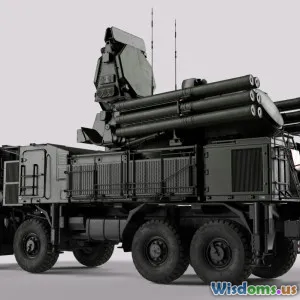
Why Modular Armor Systems Matter for Urban Law Enforcement
9 min read Exploring how modular armor systems revolutionize protection and flexibility for urban law enforcement agencies in complex environments. (0 Reviews)
Why Modular Armor Systems Matter for Urban Law Enforcement
Urban law enforcement officers face some of the most unpredictable and dynamic environments in the world. The dense and complex urban landscape involves narrow alleys, crowded streets, high-rise buildings, and a diverse populace with rapid-evolving threats — from active shooters to IEDs and chemical hazards. Given these challenges, traditional static protective gear can often fall short. Enter modular armor systems: a revolutionary approach to body armor design that offers remarkable flexibility, customization, and protection calibrated to specific operational needs.
In this article, we delve into why modular armor systems have become essential tools for urban law enforcement agencies. We’ll dissect the operational imperatives, technological innovations, and real-world impacts that make modular armor a serious gamechanger.
What Are Modular Armor Systems?
Before exploring the “why,” it’s crucial to understand the “what.” Modular armor systems refer to body armor platforms constructed with multiple components that can be assembled, removed, or swapped depending on mission requirements. Unlike traditional full-coverage armor vests, modular systems feature detachable plates, adaptable pouches, adjustable rigging, and specialized inserts (such as trauma pads or ballistic shields).
Common features include:
- Interchangeable Plates: Armor panels that vary in ballistic protection levels and can be inserted or removed.
- Attachment Points: MOLLE (Modular Lightweight Load-carrying Equipment) systems allow for adding pouches, holsters, or communication devices as needed.
- Integration With Tactical Gear: Designed to seamlessly work alongside helmet systems, radios, and breathing apparatus.
Manufacturers such as Crye Precision, AR500 Armor, and Point Blank Enterprises lead the innovation curve in producing modular body armor used by police SWAT teams and federal agencies.
Why Modularity Matters in Urban Environments
1. Flexibility to Adapt to Varied Threats
Urban law enforcement officers can go from routine patrol to high-risk tactical operations in minutes. Interactions vary from traffic stops and crowd control to hostage crises with armed adversaries.
Example: In 2019, officers responding to an active shooter in a metropolitan subway station needed different protection levels for ballistic threats vs. situations involving chemical irritants from smoke grenades. Modular armor helped operators quickly add riot shields, chemical protection panels, and reinforced ballistic plates tailored to the threat.
2. Enhanced Mobility and Comfort
Urban policing demands agility. Bulky or overly heavy armor slows movement, reduces situational awareness, and can increase officer fatigue — ultimately compromising safety.
Modular armor allows officers to optimize weight by shedding non-essential components during patrols. During high-risk incidents, full plating can be mounted temporarily. Studies have shown modular systems can reduce overall weight by up to 30% compared to traditional fixed armor, increasing mobility without sacrificing protection.
3. Improved Longevity and Cost-Efficiency
Instead of replacing entire vests, damaged or outdated components can be swapped out as technology advances or as operational needs change. This approach saves departments significant expenditures, crucial amid budget constraints. The U.S. Department of Homeland Security has cited modular armor procurement as a cost-efficient measure in its recent Law Enforcement Protective Equipment report (2022).
4. Integration with Communication and Surveillance Technologies
Modern enforcement is tech-driven. Modular armor systems facilitate seamless integration with body-worn cameras, tactical radios, and sensor arrays. For example, detachable mounts incorporated into armor plates streamline attachment of real-time surveillance tools essential in urban tactical decision-making.
Real-World Impact and Case Studies
Case Study 1: NYPD Tactical Response Unit
The New York Police Department’s specialized units have transitioned to modular armor to navigate densely populated boroughs with unpredictable threats. Officers report being able to customize gear quickly, transitioning from lightweight formations for foot patrols to 'full battle rattle' configurations in counterterrorism operations.
The modular approach has also been pivotal during public demonstrations, enabling rapid adjustments from riot shield deployment to lightweight dispersal gear.
Case Study 2: Los Angeles Police Department (LAPD) SWAT
In an official LAPD briefing on equipment modernization (2023), officers detailed how modular armor improved their effectiveness during conditional clearances of multi-story structures — a common urban operation. The ability to remove frontal plates for enhanced maneuverability while retaining back protection during stair navigation was cited as key.
These real-time adaptations potentially reduce casualties in tactical confrontations.
Technological Innovations Driving Modular Armor
Recent advancements have made modular systems smarter and more protective:
- Advanced Ballistic Materials: Ceramic and ultra-high-molecular-weight polyethylene (UHMWPE) plates reduce weight while raising protection levels.
- Smart Sensors: Integrated health sensors monitor impact levels and officer vitals, instantly alerting command centers.
- Quick-Release Systems: Innovative fasteners enable swift removal of armor in emergencies, speeding medical interventions.
These collective innovations extend the possibilities for urban law enforcement to respond to evolving threats efficiently.
Challenges and Considerations
Despite clear advantages, modular armor systems aren’t without challenges:
- Training Requirements: Officers must be well-trained in configuring and adapting their armor swiftly and correctly to maintain protection integrity.
- Standardization: Different agencies adopting diverse modular platforms can create interoperability issues during joint operations.
- Maintenance: More components mean increased maintenance diligence is required to prevent equipment failure.
Agencies implementing these systems must ensure rigorous training protocols and procedural standardization to maximize the benefits.
The Future of Urban Law Enforcement Protection
As urban crime evolves — including cyber-assisted crimes, drones, and hybrid threats — law enforcement armor has to keep pace. Modular armor represents not just an equipment upgrade but a philosophy of adaptability and responsiveness.
There is increasing advocacy among policy experts for wider adoption of modular armor systems alongside enhanced officer wellness and data-driven deployment strategies to reduce urban policing risks.
Conclusion
Cities are vibrant, complex ecosystems requiring law enforcement equipped with smart, adaptable gear. Modular armor systems deliver tailored protection precisely where and when it’s needed, safeguarding officers without compromising mobility. Their rising adoption across successful urban police forces highlights a clear trend: modularity isn’t just a design choice — it’s an operational imperative in contemporary urban law enforcement.
Investing in modular armor means investing in the safety and effectiveness of those who serve and protect our cities every day.
By keeping officers safer and more agile, modular armor systems redefine what it means to confront danger in the urban jungle.
Rate the Post
User Reviews
Popular Posts

















